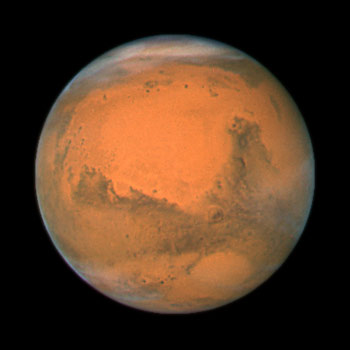On Tuesday, April 22nd, David Brain gave a lecture all about Mars. There has been much discussion about whether or not Mars had water on its surface and what happened to that water. David Brain works at the Laboratory for Atmospheric and Space Physics as well as the Department of Astrophysics and Atmospheric Science at CU Boulder. He has spent a lot of time studying the surface of Mars, and examining the differences between Mars and Earth that would cause such different environments, when the ancient Martian surface was likely similar to Earth’s modern environment.
Currently, the surface of mars isn’t simply dry, red, and cold. Mars does have poles which are covered in solid Carbon Dioxide, and a very thin atmosphere. There are visible clouds, dust devils, dunes, volcanoes, and impact craters on its surface. The thin Martian atmosphere is very cold, toxic, and thin. The average temperature on the surface is -60° F with a common low of -240° F and high of 20° F. Water simply cannot exist in a liquid state with those temperatures. Mars’s atmosphere is 95% Carbon Dioxide, which is similar to Venus’s current atmosphere, and that of ancient Earth before terrestrial live truly thrived. Most of these characteristics are expected of a dry cold planets, and water simply cannot exist in a liquid state with those conditions.
But there are formations on the surface of Mars which strongly suggest the past presence of liquid water on the surface of Mars. From satellite images, old riverbeds and deltas are seen leading to eroded craters. The patterns that rivers form as they flow are very distinct, and cannot be formed by anything but a free flowing liquid. The wind on Mars have formed dunes and eroded volcano, but the riverbeds on Mars are shockingly similar to those on Earth. The delta formations on the edges of some craters can only be formed from the occasional flooding from a river system. And the smooth edges from the same craters are also similar to what is seen on Earth from thousands of years of water erosion.
The layered terrain on Mars also suggests the existence of water. Standing water forms layers of sediment which leave clear distinct patterns as the sediment forms into rock. As the standing water recedes and reappears over time, more and more layers are added making more and more distinct patterns. The fact that these layers are seen in certain places on Mars, strongly supports that there was water on mars at one point in time. There are also observable floodplains on the surface of Mars. While rocks eroded by the wind can be jagged, rocks eroded by water become smooth and round. The fact that large planes with smooth round rocks have been observed on Mars’s surface suggests the existence of large bodies of water at some point in the past.
Chemical evidence of the existence of water on ancient Mars has also been discovered. phyllosilicates are basically clay formed by liquid water. And carbonate is a salt of carbonic acid which in its organic state suggests the presence of liquid water. The carbonate on Mars was only uncovered when asteroids collided with the surface and left large craters. The discovery of these phyllosilicates and carbonates means that it was liquid water, and not any other liquid, which had to have existed on the ancient Martian surface and left the riverbeds, delta, layered rock.
But if the evidence for water on Mars is so strong, where did it all go? What could have happened to make all the water disappear? Much of the water was believed to have been absorbed into the planet’s crust where it may still exist in a solid state. However, if all the water was underground, then there would be much more evidence seen in the craters, so some of it must have been pulled from the planet itself.
The primary reason that Earth is covered in liquid water is because the insulation that its atmosphere provides. Because of all the similarities between the Earth and Mars, it can be concluded that Mars’s atmosphere was once as thick as the Earth’s is now, or possibly even thicker. But how did the atmosphere get so thin? The answer lies in the fact that Mars no longer has a magnetic field, which can protect it from solar winds. As solar winds approach the Earth, the magnetic field produced by Earth’s magnetic poles disrupts them and cushions the blow from the intense solar winds. But as Mars grew older, the magnetic poles grew weaker as the core of the planet began to solidify. The core of Mars isn’t yet solid and Mars still has a slight magnetic field, but it isn’t nearly strong enough to protect it from solar winds. As solar winds interact with a planet’s atmosphere, bits of its atmosphere are rubbed off. Sometimes this happens as a steady stream and sometimes large chunks of atmosphere are torn free from the planet’s gravitational pull.
But if Mars used to be so similar to Earth, why is the Earth still capable of sustaining life while Mars is not? The answer is simple:Earth is bigger. The Earth’s radius is twice as big as Mars’s radius, which means that the volume of Earth eight times greater than that of Mars. Because the core is so much bigger, it takes much longer for it to solidify and for the Earth to lose its protective magnetic field. One day, many many years from now, Earth may suffer the same fate as Mars has.



'What Happened to the Ancient Martian Atmosphere?' has no comments
Be the first to comment this post!